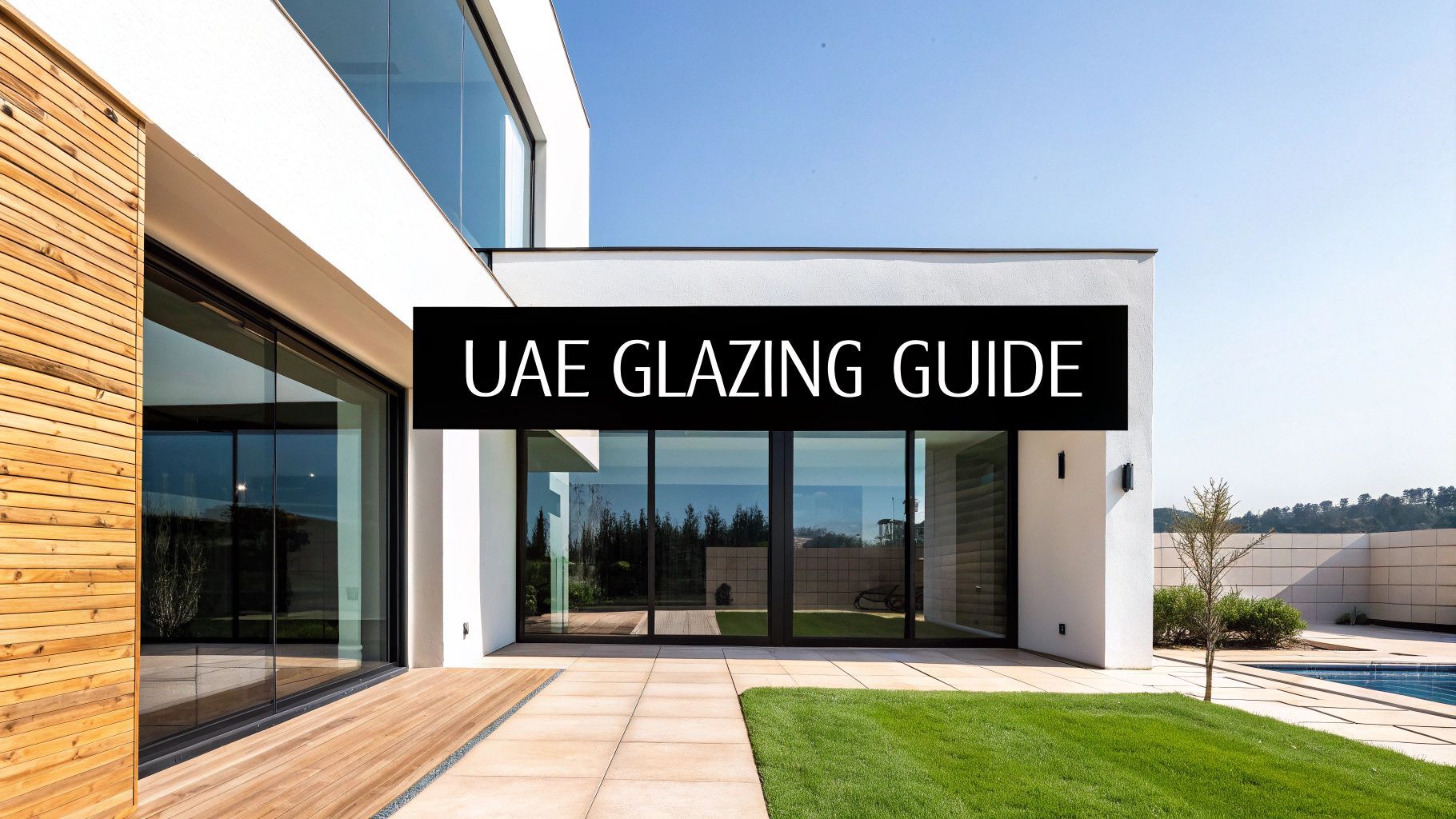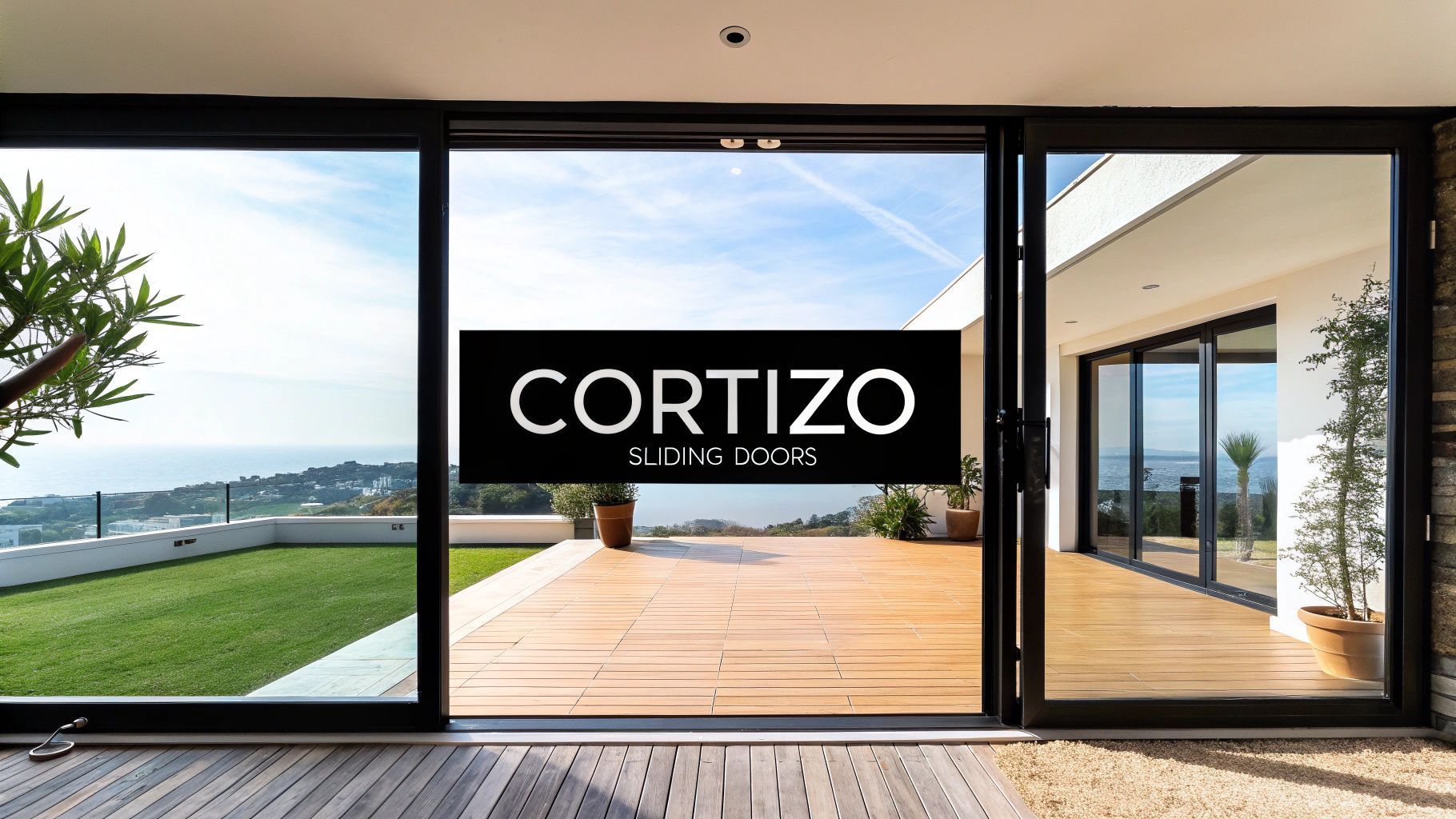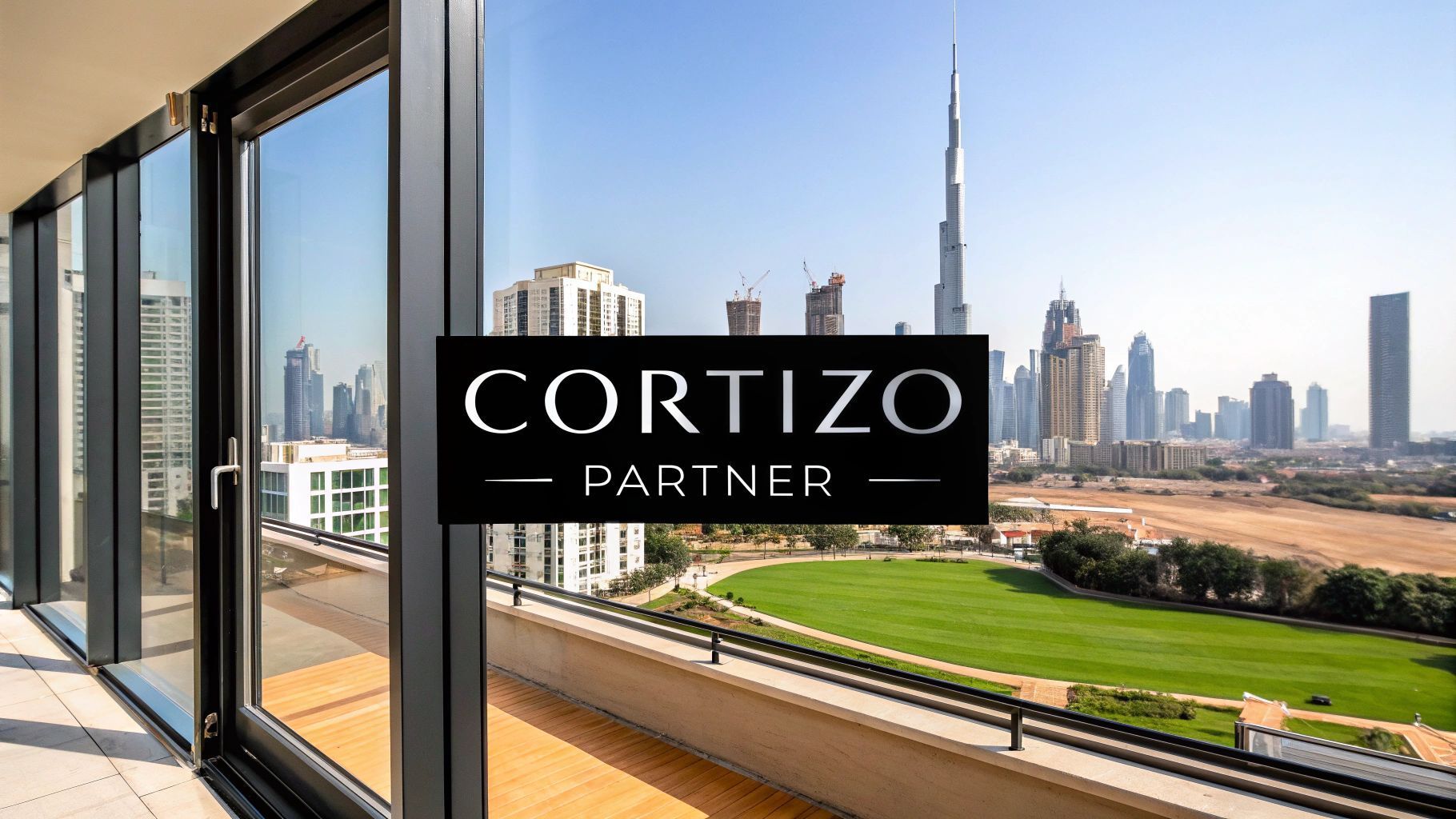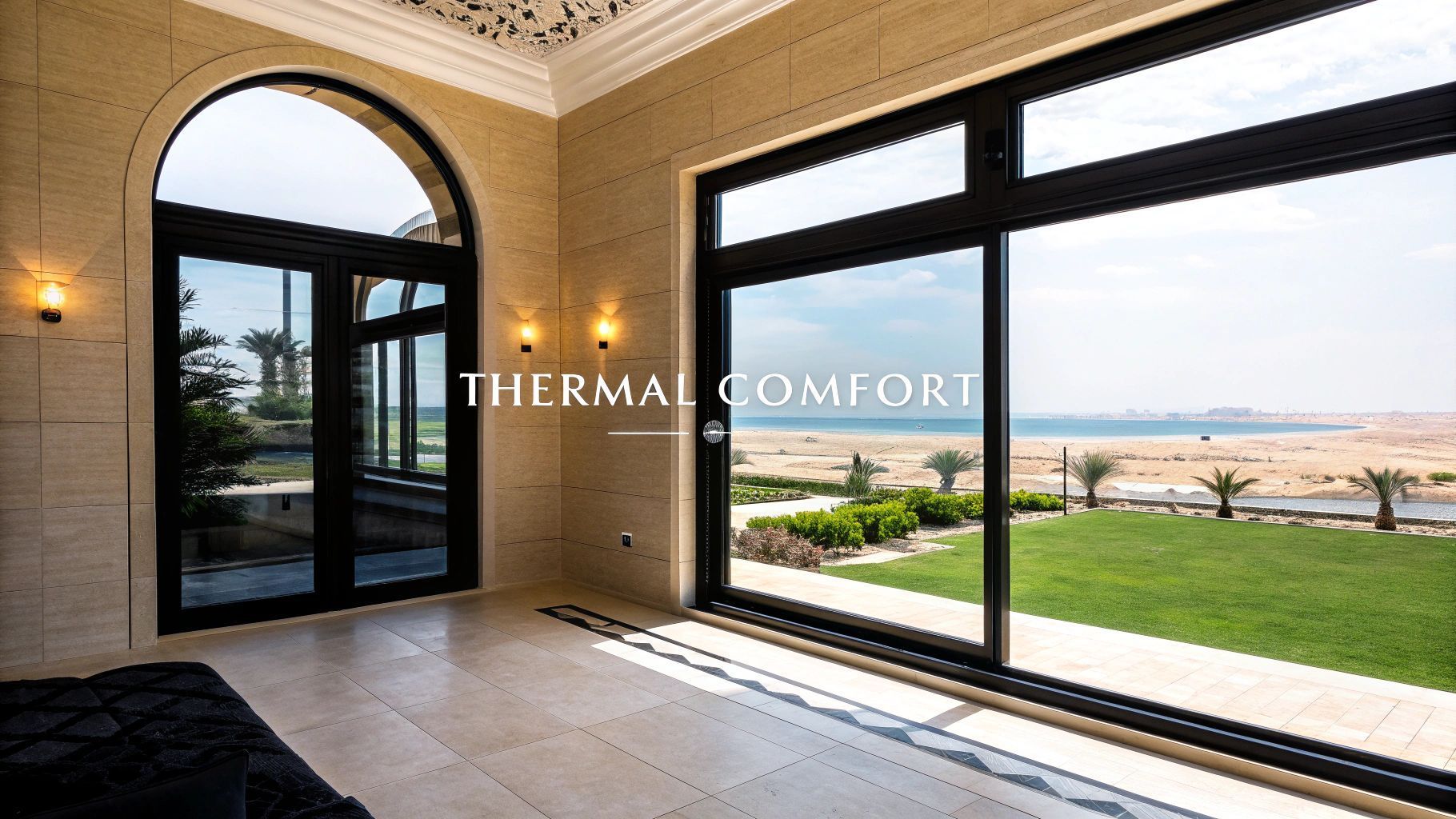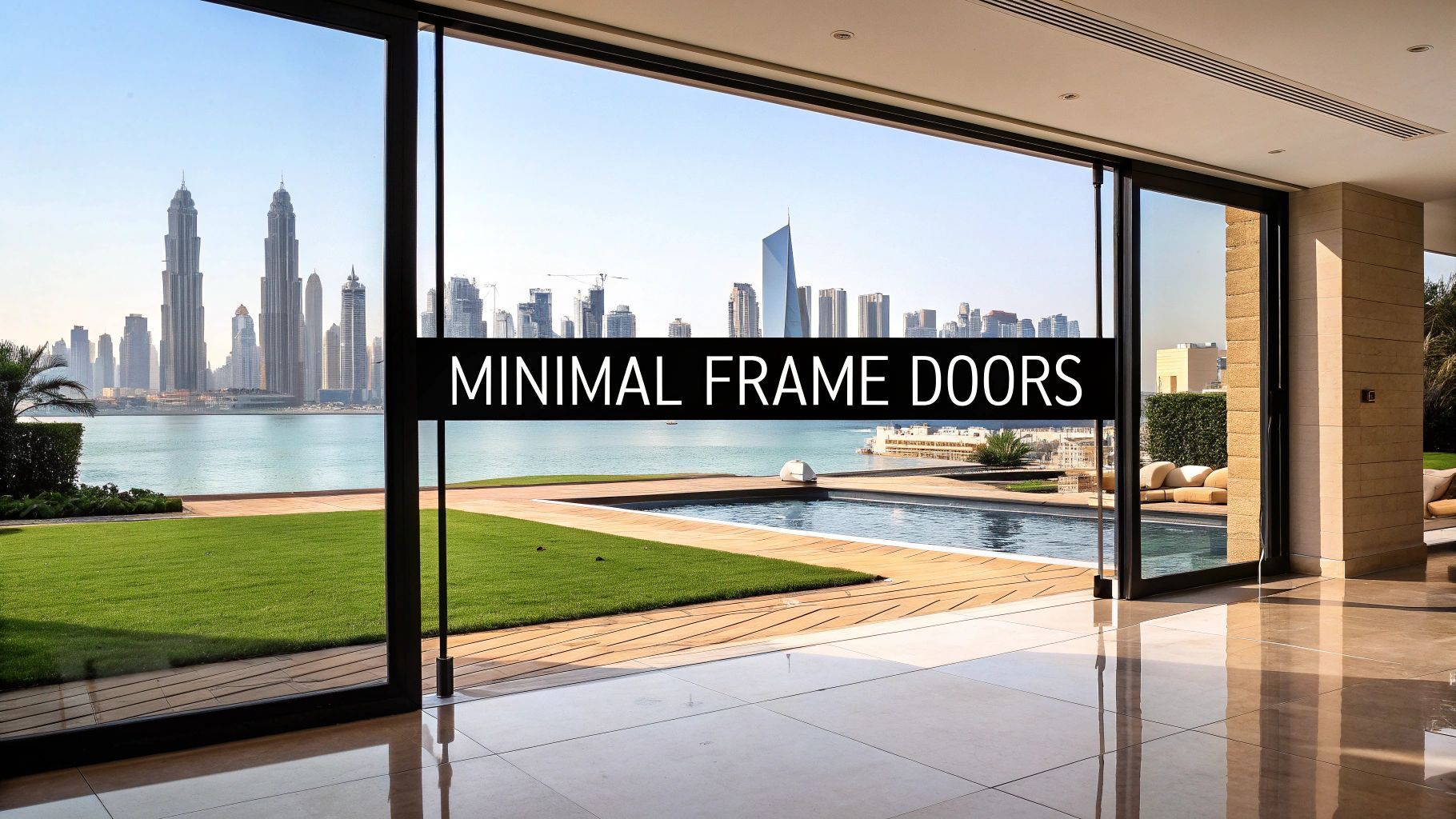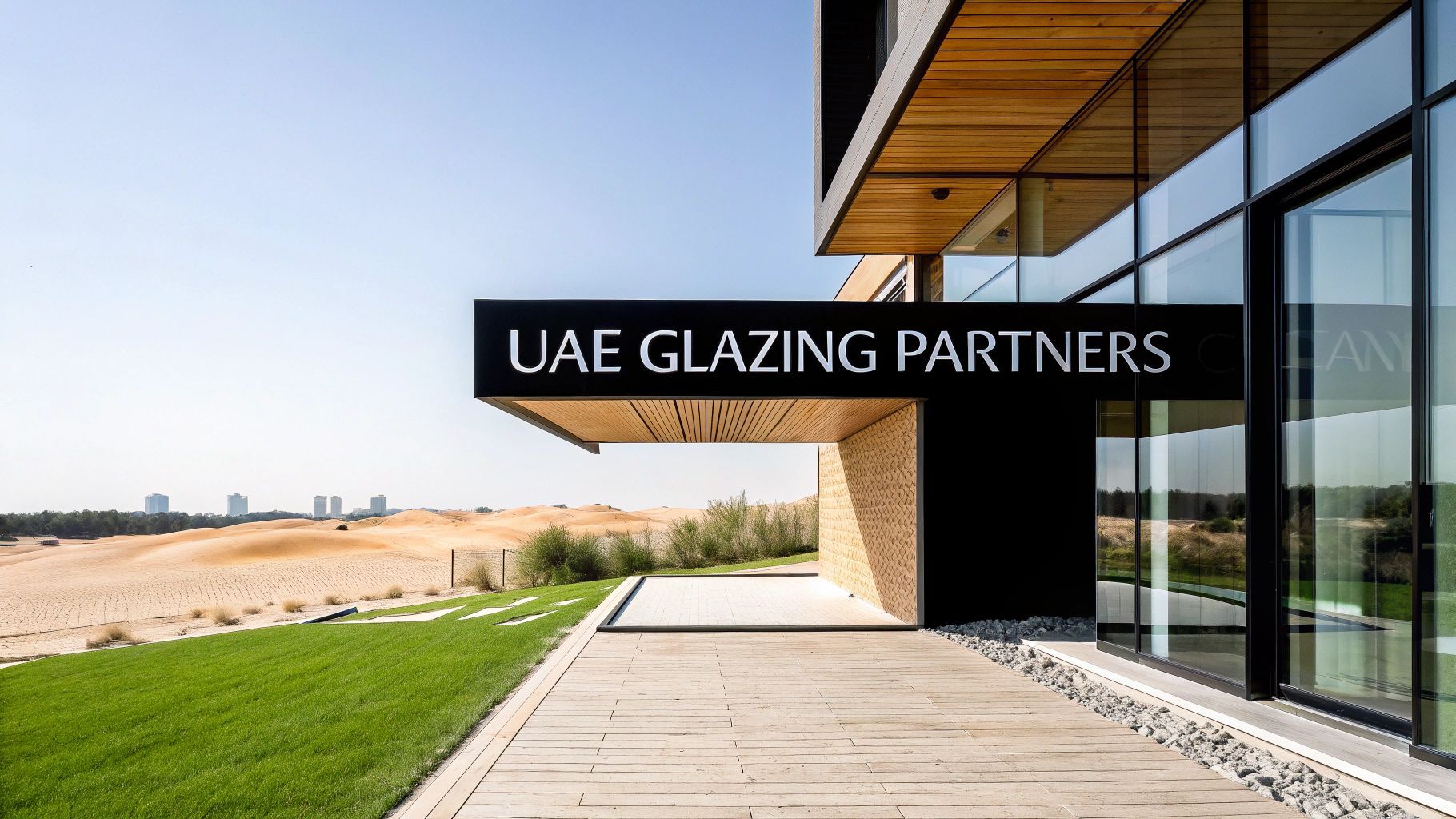A Homeowner's Guide to Composite Aluminium Cladding in the UAE
A Homeowner's Guide to Composite Aluminium Cladding in the UAE
Imagine wrapping your villa in a sleek, protective skin that looks stunning and shields it from the UAE's demanding climate. That's composite aluminium cladding in a nutshell.
It's a high-tech 'sandwich' panel made of two thin aluminium sheets bonded to a non-aluminium core. This clever construction makes it lightweight yet incredibly strong and durable.
Understanding Composite Aluminium Cladding

Think of composite aluminium cladding as both architectural armour and a beautiful finish for your home. Its real strength comes from its layered design, engineered for performance.
The outer aluminium skins provide a tough, weather-resistant barrier. The central core gives the panel its rigidity, thermal insulation, and soundproofing qualities, creating a material far more versatile than a simple metal sheet.
For villas in communities like Palm Jumeirah or Arabian Ranches, this material delivers a clean, contemporary look that can handle intense heat, dust, and humidity. It's not just decoration—it's a critical part of a high-performance home.
The Core Components and Their Roles
The secret to composite aluminium cladding’s success lies in how its layers work together. Each part has a specific job, especially when facing the sun, sand, and humidity of Dubai and Abu Dhabi.
Here's a quick look at how the layers are engineered to perform in the UAE climate.
Composite Aluminium Cladding at a Glance
| Component | Material | Primary Function in the UAE |
|---|---|---|
| Outer Aluminium Sheet | Coated Aluminium Alloy | Acts as the first line of defense against sun, dust, and humidity. The coating prevents fading and corrosion. |
| Inner Core | Polyethylene (PE) or Fire-Retardant (FR) Mineral Blend | Provides rigidity, structural stability, and insulation against heat and noise. The FR core is crucial for fire safety. |
| Inner Aluminium Sheet | Aluminium Alloy | Balances the panel, ensuring it stays flat and stable through extreme temperature swings. |
This multi-layer system allows architects to create the bold, seamless exteriors you see on modern villas—designs that are difficult or expensive to achieve with traditional render or stone.
The aluminium sheets themselves are a product of sophisticated manufacturing. To understand the base material, it's worth exploring the aluminium extrusion profile process. This technology helps create the high-performance building materials modern UAE homes demand.
Why Modern UAE Villas Need Composite Cladding
Life in the UAE throws unique challenges at any building. Intense heat, constant dust, urban noise, and humidity demand an exterior that’s more than just a pretty face. Composite aluminium cladding is engineered to tackle these exact issues head-on.
For homeowners in communities like Dubai Hills Estate or Arabian Ranches, the right cladding doesn't just boost curb appeal; it makes your home more comfortable, efficient, and durable. It’s a smart investment in your property's value and quality of life.
Superior Thermal Performance and Energy Savings
The relentless UAE sun can turn a villa into an oven, straining air conditioning systems. Composite aluminium cladding acts as a thermal shield, reducing the amount of solar heat that penetrates your walls.
This is often achieved with a ventilated façade system. This creates an air gap between the cladding and the structural wall, letting hot air escape before it heats up your home. The result is a cooler indoor space and a welcome drop in your DEWA bills.
"A properly installed composite cladding system can reduce a building's energy consumption for cooling. In a climate where AC is a major expense, those savings add up significantly."
Unmatched Durability Against Sand and Dust
Frequent sandstorms and fine dust can quickly wear down traditional painted surfaces. Composite aluminium cladding, on the other hand, is built tough for this environment.
The panels are finished with a robust PVDF (Polyvinylidene Fluoride) coating. This advanced finish is incredibly smooth, so dust has a hard time sticking. When it does build up, a simple rinse is usually all it takes to wash it away, keeping your villa looking sharp with minimal effort.
Excellent Sound Insulation for Urban Peace
As cities like Dubai and Abu Dhabi expand, noise from traffic and construction is a growing issue. The material's layered "sandwich" structure is brilliant at dampening external sound vibrations.
This natural soundproofing quality helps create a much quieter interior, giving you a tranquil escape from the hustle and bustle outside. It’s an invaluable benefit for villas located near main roads or in developing communities.
Many architects prefer aluminium systems for residential projects because of these performance benefits, combining cladding with high-quality windows and doors for total insulation.
Resisting Humidity and Preventing Corrosion
The coastal humidity in places like Palm Jumeirah can be brutal on building materials. Aluminium is naturally resistant to corrosion, forming its own protective oxide layer that stops rust.
The high-quality coatings on composite panels add another layer of defense against moisture and salty air. This means the cladding won't warp, swell, or degrade, guaranteeing a long and reliable lifespan for your villa's exterior.
Choosing the Right Cladding for Your Villa
Picking the right composite aluminium cladding for your UAE villa is about more than just colour. It's a decision that impacts your home's safety, longevity, and aesthetic appeal.
For architects and homeowners in Dubai and Abu Dhabi, the challenge is balancing stunning design with the practical demands of the region. From navigating fire safety codes to ensuring the finish can handle the sun, every detail counts.
This chart breaks down how composite aluminium cladding solves key environmental challenges for UAE villas.
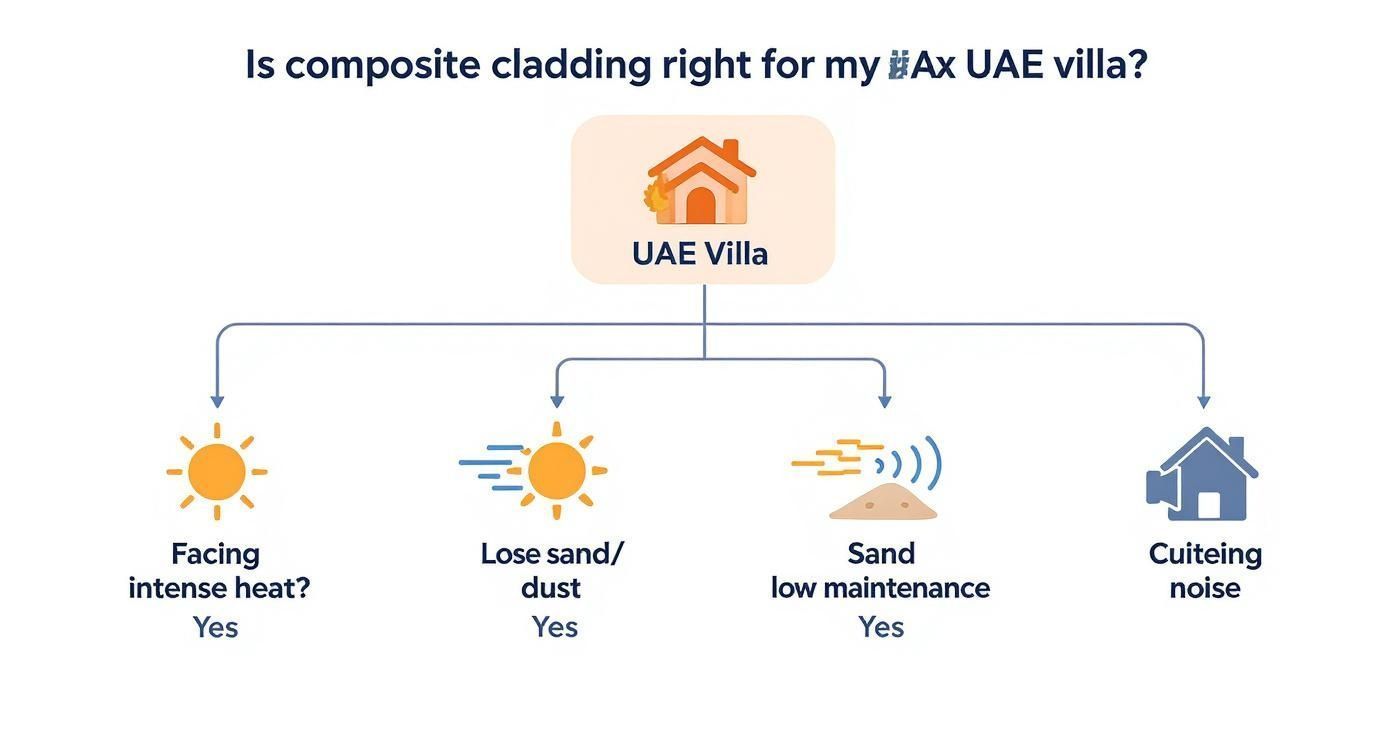
As you can see, the material delivers specific solutions that make your home more comfortable and easier to maintain.
Core Material: The Foundation of Safety
The single most critical choice is the core material inside the panel. This is a fundamental issue of safety and compliance with local regulations.
- Polyethylene (PE) Core: This is a standard, often cheaper, option. However, PE is a combustible thermoplastic and is not compliant with current UAE building codes for most residential applications.
- Fire-Retardant (FR) Core: This core is filled with non-combustible minerals. It is engineered to resist fire and limit its spread, making it a vastly safer and mandatory choice.
"In the UAE, following Civil Defence regulations is non-negotiable. For any residential villa, specifying a fire-retardant (FR) core is mandatory to protect residents and meet local building codes."
Opting for an FR core gives you peace of mind, knowing your home’s facade adds a crucial layer of protection.
Finishes That Define Your Villa's Character
Once safety is covered, you can explore the finishes. Composite aluminium cladding offers a massive world of colours and textures, letting you create almost any look you can imagine.
Imagine a sleek villa on Palm Jumeirah with a metallic silver finish that reflects the sunlight. Or a contemporary home in Arabian Ranches with a realistic wood-effect cladding that offers warmth without the risk of warping, fading, or rotting.
Popular finishes include:
- Solid Colours: Clean, modern, and available in any shade.
- Metallic Finishes: Add sophistication with brushed silver or anodized bronze.
- Wood Effects: Mimic the look of natural timber with incredible realism.
- Stone and Marble Effects: Get a luxurious look without the massive weight and cost.
When choosing a finish, it's also smart to consider its environmental footprint. Consulting resources like this UK Guide to Sustainable Materials for Construction can help ensure your project is responsible.
The Ultimate Shield: PVDF Coatings
The final layer protecting your cladding is its coating. In the Middle East, the sun’s UV radiation is relentless, and inferior coatings will fade and chalk in just a few years.
This is why PVDF (Polyvinylidene Fluoride) coatings are the gold standard for high-quality composite aluminium cladding in the UAE. This advanced finish is incredibly resistant to UV rays, chemicals, and scratches, ensuring your colour stays vibrant for decades.
Core Material and Coating Comparison for UAE Climate
| Feature | Standard Core (PE) | Fire-Retardant Core (FR) | PVDF Coating |
|---|---|---|---|
| Fire Safety | Combustible; not compliant for most residential use in the UAE. | High mineral content; resists fire spread and meets Civil Defence codes. | Does not impact core fire rating but is a stable, non-reactive surface. |
| Durability | Prone to delamination in extreme heat over time. | Stable and durable, designed for high-performance applications. | Exceptional resistance to UV fading, chalking, and chemical exposure. |
| Best For | Not recommended for villas in the UAE. | All residential villas, high-rise buildings, and public-facing projects. | Any exterior application in the UAE to guarantee long-term color stability. |
| Key Benefit | Lower initial cost. | Maximum safety and compliance. | Decades of fade-resistant aesthetic appeal. |
Combining an FR core with a PVDF coating gives you uncompromising safety and a finish that will look pristine for years, no matter what the Dubai sun throws at it.
Inspiring Designs in UAE Residential Architecture
Beyond its technical benefits, composite aluminium cladding is a powerful tool for architectural creativity. In the UAE, where cutting-edge design must meet a harsh climate, this material brings ambitious visions to life.
From sleek beachfront homes on Palm Jumeirah to family villas in Arabian Ranches, architects use these panels to craft stunning facades, sharp lines, and dramatic feature walls. This versatility offers design freedom that traditional materials can't match.
Creating Cohesive and Modern Villa Facades
One of the best things about composite aluminium cladding is its ability to create a unified, contemporary exterior. Its smooth finish allows architects to design building envelopes that feel cohesive and minimalist.
For example, a modern villa in Dubai Hills Estate might feature large areas of crisp white cladding against sections of dark, textured panels. This interplay adds visual depth, highlighting the home's geometric forms.
The real magic happens when you pair cladding with high-performance window and door systems. When used alongside advanced glazing like Cortizo Cor Vision Plus sliding doors or Vetro Slide systems, the cladding frames the glass perfectly, creating a seamless connection between inside and out.
Reimagining Tradition with Modern Materials
Composite aluminium cladding is also fantastic for renovating older villas. By strategically adding panels in a metallic bronze or charcoal grey to a classic villa in Jumeirah, a homeowner can introduce sharp, modern accents.
These panels can be used to:
- Frame Entrances: Create a bold, welcoming entryway.
- Highlight Features: Draw attention to rooflines, balconies, or window bays.
- Construct Modern Extensions: Seamlessly blend a new addition with the existing home.
This approach upgrades the home's aesthetic and boosts its resilience against the climate.
The Natural Look Without the Maintenance
For those who love the warmth of timber or the elegance of stone but dread the upkeep, hyper-realistic natural finishes are the answer. These panels provide the desired look without the hassle.
A villa in a green community like Al Barari could feature wood-effect cladding that offers the rich texture of real timber. Unlike wood, this composite aluminium cladding won't warp in the humidity, fade in the sun, or require yearly sealing.
A stone-effect panel can deliver the premium look of marble or granite at a fraction of the weight and cost, making it feasible for large feature walls or entire facades.
This blend of form and function ensures the final result is visually striking and perfectly suited to life in the UAE.
Installation and Maintenance Best Practices
Choosing a high-quality composite aluminium cladding is only half the battle. A flawless, long-lasting finish comes down to professional installation and proper care.
The installation process is about creating a high-performance building envelope engineered for the UAE’s climate. Every detail matters, from sealing joints against sand to managing intense heat.
The Importance of a Ventilated Facade
A critical installation technique for our region is the ventilated facade (or rainscreen system). This method boosts thermal performance and moisture control in hot, humid climates.
Installers mount the cladding onto a sub-frame, creating an air gap between the panel and the villa's structural wall. This space allows hot air to rise and escape, preventing solar heat from reaching the building. The result is a reduced load on your AC and lower energy bills.
This intelligent approach is becoming the standard. Regional market growth drivers show a rising demand for cladding systems that offer weather resistance and energy efficiency.
Sealing Against Sand and Water Ingress
Proper sealing is non-negotiable in the UAE. Fine sand can find its way into the tiniest gaps, while sudden rain can test water tightness. Professional installers use high-quality silicone sealants designed to remain flexible in extreme temperatures.
A correctly sealed system creates an impenetrable barrier. This prevents sand from causing abrasive damage and stops water from getting behind the facade, which could lead to serious structural issues over time.
Simple Maintenance for Lasting Beauty
One of the best things about composite aluminium cladding is how little maintenance it needs. However, a simple cleaning routine will keep it looking pristine.
Actionable Maintenance Tips:
- Regular Rinsing: A quick wash with a low-pressure hose is usually enough to remove surface dust.
- Gentle Washing: For stubborn dirt, use a soft cloth with water and a mild, non-abrasive detergent. Never use harsh chemicals, as they can damage the protective coating.
- Annual Checks: Once a year, inspect the sealant in the joints to ensure it’s intact.
These simple steps will keep your villa's exterior looking impressive for years. For more advice, check out our 5 maintenance tips for aluminium windows and doors in the UAE climate—many of the same principles apply.
Planning Your Villa Transformation
Composite aluminium cladding is a strategic investment in your UAE home’s comfort, efficiency, and long-term value. It solves the region's biggest climate challenges—from heat to sand—while offering incredible design freedom.
Whether you’re building a new villa in Dubai Hills Estate or renovating a home in Arabian Ranches, the next step is turning your vision into reality. This means choosing the right materials and partnering with experts who understand the local environment. Exploring various home exterior renovation ideas can help refine your final aesthetic.
"A great transformation is holistic. It’s not just about the cladding but how it works with every other part of your home, like your windows and doors, to create a seamless and efficient building envelope."
Consider pairing sleek cladding with high-performance glazing. Systems like Cortizo's Cor Vision Plus sliding doors or thermally broken Cor 70 windows enhance the modern look while cutting energy costs. You could also integrate robust Vetro Slide systems, Deceuninck uPVC windows, or Vetromax facades to further insulate against heat and noise. Getting that flawless result comes down to the right mix of materials and expert guidance.
Got Questions? We’ve Got Answers
When considering composite aluminium cladding for a villa in the UAE, practical questions often arise. Here are answers to some common queries.
How Does This Cladding Handle Extreme Summer Temperatures?
It’s built for the heat. The material’s reflective surface and the air gap in a ventilated facade system work together to significantly reduce heat transfer. This means less solar energy enters your villa, resulting in a cooler interior and lower AC bills during peak summer months.
Is It Difficult to Clean in a Dusty Climate?
Not at all—it’s remarkably low-maintenance. The smooth, non-porous PVDF coating doesn't give dust much to cling to. Unlike textured render that traps sand, these panels allow dirt to be washed away easily. A simple rinse with mild, non-abrasive soap and water is usually enough to restore the facade's look, even after a sandstorm.
What’s the Realistic Lifespan on a UAE Villa?
When professionally installed and featuring a high-quality PVDF coating, composite aluminium cladding can last for decades. The advanced finish is highly resistant to the fading and chalking caused by intense UV radiation. It also stands up to corrosion from coastal humidity and resists delamination from temperature swings, offering an excellent long-term return on your investment.
This cladding is a genuine performance upgrade. It's designed from the ground up to handle the specific environmental challenges we face in the UAE, from the dry heat of Abu Dhabi to the humid air of Palm Jumeirah.
If you're planning a renovation or villa upgrade in the UAE, Swift Rooms can help you specify the best window and door system for your project. Contact us today for a quote or consultation.



